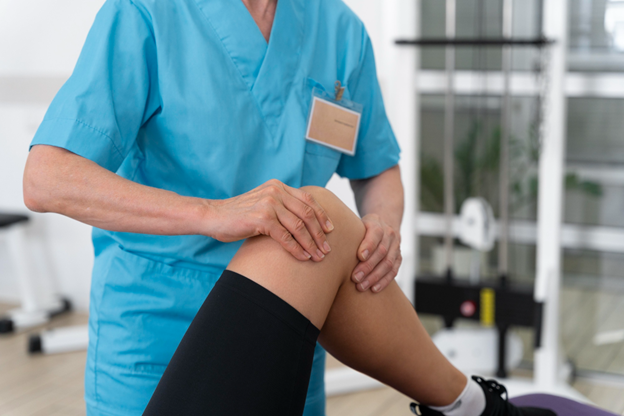Introduction
Knee pain is one of the most common complaints among individuals of all ages and can arise from various causes, including injury, overuse, or chronic conditions like osteoarthritis. The knee joint, being one of the largest and most complex joints in the body, plays a crucial role in enabling movement, stability, and mobility. When knee pain occurs, it can significantly affect daily activities and quality of life.
Physiotherapy is a highly effective treatment option for managing knee pain, whether it results from an acute injury or a chronic condition. It helps restore function, reduce pain, and prevent further injury. In this blog, we will explore how physiotherapy can help alleviate knee pain, the techniques used, and the role of physiotherapists in the rehabilitation process.
Understanding Knee Pain
Knee pain can be categorized into two main types: acute and chronic. Acute knee pain often results from sudden injuries like sprains, fractures, or ligament tears, while chronic knee pain is typically the result of ongoing conditions like osteoarthritis or patellofemoral pain syndrome.
Common causes of knee pain include:
- Osteoarthritis: A degenerative joint disease where the cartilage in the knee wears away, leading to pain, stiffness, and limited mobility.
- Ligament Injuries: Injuries to the anterior cruciate ligament (ACL) or medial collateral ligament (MCL) are common in sports and physical activities.
- Meniscus Tears: The meniscus is the cartilage that acts as a cushion between the bones in the knee. Tears can occur due to sudden twisting movements.
- Patellofemoral Pain Syndrome: Also known as “runner’s knee,” this condition occurs when the kneecap (patella) doesn’t move smoothly over the femur, causing pain.
How Physiotherapy Helps with Knee Pain
Physiotherapy for knee pain focuses on treating the underlying causes of discomfort and restoring function. Physiotherapists use various techniques to help relieve pain, improve strength, and increase range of motion. Here are the primary ways physiotherapy can help:
- Pain Reduction:
Physiotherapists use modalities like heat or cold therapy, ultrasound, and electrical stimulation to reduce inflammation and manage pain. These techniques help control swelling and promote healing of the affected tissues. - Restoring Strength:
Knee pain can lead to muscle weakness, especially in the quadriceps (front thigh muscles) and hamstrings. A physiotherapist will guide you through strengthening exercises that target these muscle groups, helping to stabilize the knee joint and reduce the risk of future injury. - Improving Flexibility:
Tight muscles around the knee can limit its range of motion and contribute to pain. Stretching and mobility exercises can help increase flexibility, allowing for better knee function and movement. - Correcting Posture and Gait:
Poor posture or abnormal walking patterns can place extra stress on the knee joint, exacerbating pain. Physiotherapists analyze your posture and gait, providing strategies to improve your alignment and movement mechanics. - Preventing Future Injuries:
Physiotherapists educate patients on proper body mechanics and techniques for avoiding strain during everyday activities or sports. They can also design customized exercise programs to strengthen the knee and prevent future injuries.
Common Physiotherapy Techniques for Knee Pain
Physiotherapists use a variety of hands-on techniques and exercises to treat knee pain. Here are some common ones:
- Manual Therapy:
This involves techniques like joint mobilization and soft tissue massage to improve joint mobility, reduce muscle tension, and alleviate pain. - Strengthening Exercises:
Exercises like squats, leg lifts, and lunges can strengthen the muscles surrounding the knee, improving stability and reducing strain on the joint. - Stretching and Flexibility Exercises:
Physiotherapists will recommend specific stretches to improve the flexibility of the quadriceps, hamstrings, and calf muscles, which are crucial for proper knee function. - Balance and Proprioception Training:
Exercises that improve balance and proprioception (the body’s sense of position in space) can help prevent falls and improve stability in the knee joint. - Aquatic Therapy:
Water-based exercises reduce the impact on the knee while still allowing for strengthening and mobility exercises. This is especially helpful for individuals with severe pain or limited mobility.
The Role of Physiotherapists in Knee Rehabilitation
Physiotherapists are trained professionals who assess, diagnose, and treat physical conditions that affect movement. In the case of knee pain, physiotherapists play a critical role in guiding patients through their recovery process. The rehabilitation process involves:
- Assessment and Diagnosis:
The physiotherapist will perform a thorough assessment to identify the root cause of knee pain. This might involve evaluating your posture, range of motion, strength, and gait. - Personalized Treatment Plan:
Based on the assessment, the physiotherapist will design a tailored treatment plan that addresses your specific needs and goals. This may include a combination of exercises, manual therapy, and pain management techniques. - Ongoing Monitoring and Adjustments:
Physiotherapists closely monitor progress during rehabilitation and adjust treatment plans as needed to ensure continued improvement and optimal recovery.
When to Seek Physiotherapy for Knee Pain
If you experience any of the following symptoms, it’s time to consult a physiotherapist:
- Persistent knee pain that doesn’t improve with rest
- Difficulty walking or moving the knee
- Swelling or instability in the knee
- Pain after an injury or fall
- Difficulty performing daily activities like climbing stairs or standing for long periods
Physiotherapy is highly beneficial for treating knee pain, regardless of whether the pain is acute or chronic. By addressing the root cause of the pain and focusing on restoring function, physiotherapy can significantly improve your quality of life and prevent future injuries.
Conclusion
Knee pain can be debilitating, but physiotherapy offers an effective way to manage and overcome it. Whether you’re dealing with chronic conditions like osteoarthritis or recovering from an injury, physiotherapists are trained to help you recover, reduce pain, and regain full function. If you’re struggling with knee pain, consult a qualified physiotherapist today to start your journey toward recovery and a pain-free life.
Consult us today for expert guidance!


